The best 3D printers let you create your own DnD miniatures, wargames terrain, dice towers, and neat nerd stuff. 3D printing technology has become much cheaper and reliable over the past few years, and it’s easier than ever to get started. We’re trying and testing the best 3D printers for miniatures on the market right now.
3D printing feels like magic, and there are ever more things to use them for. You might want to print custom DnD miniatures designed on Hero Forge, or conversion bits to upgrade your Warhammer 40k factions and Age of Sigmar armies. Some of the best board game inserts and upgrades can be found on online file repositories, and there are even 3D printer files to upgrade your gaming table.
Once you’ve found the printer for your needs and budget, our guide on how to 3D print miniatures should help you get started.
Why you can trust us ✔ We spend hours testing games, toys, and services. Our advice is honest and unbiased to help you buy the best. Find out how we test.
Best 3D printers for miniatures:
- ELEGOO Mars 3 – best overall
- Anycubic Photon Mono – entry-level choice
- Phrozen Sonic Mini 8K – high-end choice
- Elegoo Neptune 3 Pro – budget choice
- AnkerMake M5C – easiest to use
- Elegoo Saturn 3 Ultra – best for huge resin prints
- Creality Ender 3 Pro – best for terrain
- AnkerMake M5 – most innovative
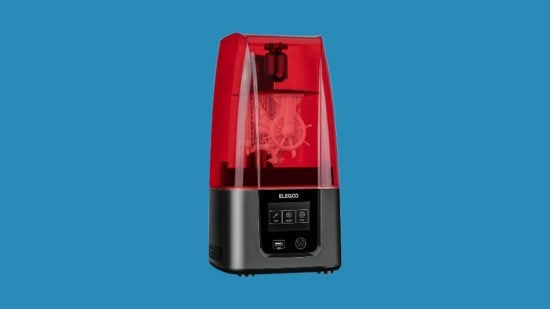
1. Elegoo Mars 3
The best 3D printer overall.
Elegoo Mars 3 specs:
| Resin | DLP Photopolymer Resin |
| User interface | 3.5-inch LCD touchscreen |
| Light source | 405nm COB UV LED |
| Dimensions | 22.7 x 22.7 x 43.85cm |
Pros
- Easy to use
- Reasonable price
- Produces highly detailed prints
Cons
- Might not be so easy for first-time users
- Plastic base feels a little cheap
The ELEGOO Mars 3 is simply the best overall 3D printer you can pick up right now. The Mars 3 is a dainty bit of kit, weighing in at only 5.2 kg – but it’s got fantastic precision for the asking price of $468 (£346) with a very impressive XY resolution of 35 microns and a minute minimum layer thickness (Z resolution) of 10 microns.
It boasts some nice quality-of-life features, such as a front-facing USB port and a simple but sizable touchscreen, though sadly it lacks a WiFi connection. It’s also fast – managing one layer every 2.5 seconds – and easy to use: calibrating the build plate is child’s play.
With excellent ease-of-use, speed, and precision, in terms of bang for your buck, the ELEGOO Mars 3 is hard to beat. Which is why we’ve dubbed it the best 3D printer for miniatures overall.
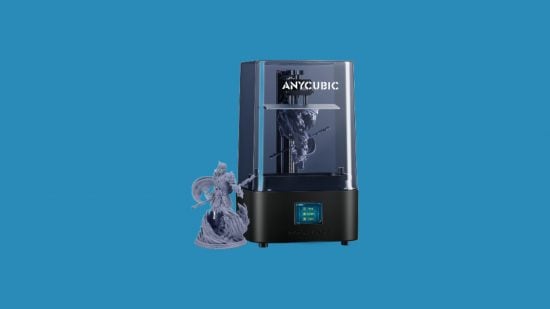
2. Anycubic Photon Mono 2
The best entry-level 3D printer.
Anycubic Photon Mono 2 specs:
| Resin | Anycubic Water Based Resin |
| User-interface | 2.8-inch touch screen |
| Light source | Parallel matrix |
| Dimensions | 39 x 22.9 x 23.5cm |
Pros
- Affordably priced
- Easy to use
Cons
- Overall cheaper feel
- Not as detailed as other 3D printers
When we say the Anycubic Photon Mono 2 is the best entry-level 3D printer, it’s not because there’s anything low-quality about the results it delivers. Indeed, with an XY resolution of 51 microns, it may not be the most detailed 3D printer on the market, but it’s still pretty precise.
Where the Anycubic Photon Mono really wins out, however, is in price, speed, and usability. It’s cheap, simple to set up out of the box, and – because it uses an LCD screen to reflect UV light onto the resin (rather than just using a laser like the earliest SLA printers) – printing times are nice and short, each layer taking 1-2 seconds.
One limitation of this 3D printer is its relatively low build volume. You can’t go above a height of 165mm (6.5 inches), so, while the Anycubic Photon Mono is ideal for printing regular D&D minis, large-scale terrain and tanks may be a no-go.

3. Phrozen Sonic Mini 8K
The best high-end home 3D printer.
Phrozen Sonic Mini 8K specs:
| Resin | DLP Photopolymer Resin |
| User-interface | 3.5-inch LCD touchscreen |
| Light source | Linear Projection LED Module |
| Dimensions | 16.5 x 7.2 x 18cm |
Pros
- Absolutely amazing print quality
- Easy to use out of the box
Cons
- Expensive
If you’re not satisfied with a 3D Printer that can be owned by the hoi polloi, want something a bit more luxurious, and are prepared to fork out the cash $801 (£592), the Phrozen Sonic Mini 8K is the best high-end home 3D printer out there.
It manages an extremely powerful XY resolution of 22 microns, to go with a Z resolution of 10 microns, and – despite the ‘mini’ in its name – has a comparable build volume to our previous recommendations. Currently available to preorder, you won’t find a better 3D printer than the Phrozen Sonic Mini 8K.
…Actually, you might. But you came to a guide for 3D printers for miniatures and wargaming and not for industrial 3D printers, so this is the highest quality you’re going to require, and we’re not going to enable you by showing you anything pricier.
Okay fine, there’s also the $1700 / £1260 Phrozen Sonic Mega 8K (with a mighty, mighty build volume of 330 x 185 x 400mm) if you really need to print, let’s say, a ginormous dragon god Tiamat with every scale lovingly rendered or something. But really, we think you’re just getting silly now.
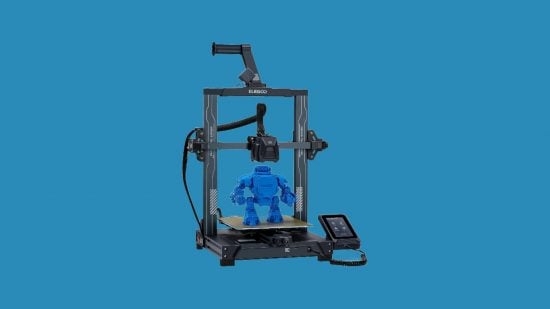
4. Elegoo Neptune 3 Pro
The best budget 3D printer.
Elegoo Neptune 3 Pro specs:
| Resin | None, FDM printer |
| User-interface | Touch screen interface |
| Light source | None |
| Dimensions | 22.5 x 22.5 x 28cm |
Pros
- Affordable pricing
- Quiet operation
Cons
- Lower-quality FDM printing
When shopping for a budget 3D printer, you want to ensure that you’re still going to get a model that can still do a decent job, and the Elegoo Nepture 3 Pro won’t let you down. It has since been succeeded by later models, but all that means is that you can grab it at an even cheaper price.
Another feather in its cap is the fact that it is very easy to assemble and get started with, so you won’t have to spend lots of time trying to figure out how to get it set up. You can practically get started right out of the box, and you don’t need to worry about it disturbing the people you live with, as it’s one of the quieter 3D printers on this list.
Obviously, it’s not going to offer quite the same level of speed, control, or quality that you get from some of the other options on this list. Still, that’s no reason to look down on the Elegoo Neptune 3 Pro, and we think this will be a stand-up option for a lot of people.

5. AnkerMake M5C
The easiest 3D printer to use.
AnkerMake M5C specs:
| Resin | None, FDM printer |
| User-interface | None – app required |
| Light source | None |
| Dimensions | 46.6 x 37.4 x 48cm |
Pros
- Really simple and easy to use
- Fantastic quality for FDM
Cons
- Lower fidelity than resin printers
- No screen
The world of 3D printers can be a daunting one, and the prospect of getting one set up and working might be enough to discourage someone from buying. If that sounds like you, we recommend going for the AnkerMake M5C, which is super easy to use.
As it uses FDM printing, rather than resin, it can’t achieve quite the same level of accuracy as you’ll get from other top 3D printers, but that doesn’t mean it’s not worth having. Wargamer’s editor, Alex, has been able to make some very detailed miniatures with another (albeit slightly larger) M5 AnkerMake printer.
Unlike most 3D printers, the AnkerMake M5C doesn’t have a screen. This means that you will have to download an app on your phone instead. It’s not a huge problem, but we know some people would prefer not to have to use their phone as it’s a much less streamlined experience than you’d get with a native screen. Still, it’s a small problem for something that is otherwise very easy and simple to use.
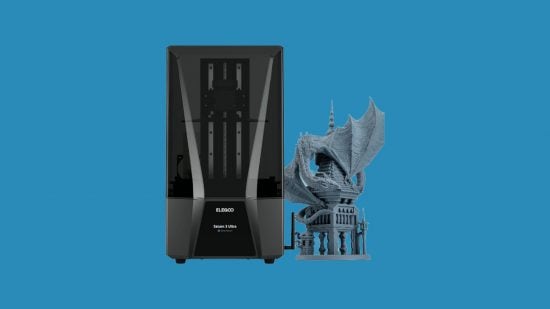
6. Elegoo Saturn 3 Ultra
The best 3D printer for huge resin prints.
Elegoo Saturn 3 Ultra specs:
| Resin | Elegoo Rapid Standard Resin |
| User-interface | 4-inch HD IPS touchscreen |
| Light source | COB Refractive |
| Dimensions | 21.9 x 12.3 x 260cm |
Pros
- Can do enormous prints
- Speedy print jobs
Cons
- Likely larger than most will need
Fancy printing some not-so-miniature miniatures? The Elegoo Saturn 3 Ultra is the best we’ve seen when it comes to creating huge resin prints. It’s ideal for things like huge, centerpiece models. It’s probably slightly larger than a lot of people will need, but it’s better to have some big enough to handle, rather than a 3D printer that might not be up to the task if you want bigger prints down the line.
It does a speedy job, even when producing huge 12k prints, and it’s relatively easy to use too. What’s particularly handy is being able to transfer files to it via Wi-Fi, allowing you to draw from any and all internet-capable devices in your house.
Obviously, it carries a slightly larger price tag than some of the smaller 3D printers on this list, and we completely understand that some readers are going to go for one of the smaller options to save a bit of money. Still, if you can afford it, this is a fantastic option.
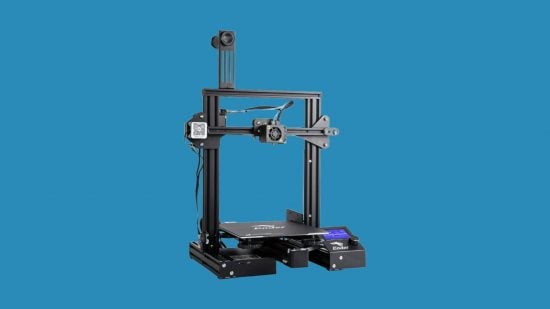
7. Creality Ender 3 Pro
The best 3D printer for terrain.
Creality Ender 3 Pro:
| Resin | None, FDM printer |
| User-interface | 3.25-inch LCD screen |
| Light source | None |
| Dimensions | 44.5cm x 43.2cm x 45.7cm |
Pros
- Ideal for printing terrain
- Simple and user-friendly
Cons
- Noisy machine
- Interface could be better
Quickly dipping back to a price that won’t make you wince, and a bit of break from the norm, the Creality Ender 3 Pro is the best 3D printer for terrain. Yes, it’s one of those plastic FDM 3D printers we mentioned – but, before you start hissing and spitting, you should know Creality Ender printers have diehard fans in RPG communities, and for good reason.
One of those good reasons is they all have really large build volumes while keeping prices low. With the Creality Ender 3 Pro you’ve got 220 x 220 x 250mm to work with, making it ideal for larger projects. It’s a superb pick if you’ve already got more models than you can ever feasibly paint (you know who you are) and want to experiment with crafting battlefield terrain and arenas instead. No one likes purchasing terrain when they could be buying more minis, so this 3D printer can certainly help you branch out.
Whereas most of the printers we’ve recommended so far come pretty much ready to go, with just a bit of calibration to do and some simple instructions to follow, the Creality Ender 3 Pro requires a bit more assembly. It’s a good 3D printer if you’re a dyed-in-the-wool tinkerer though, as, with a bit of care, you can achieve surprisingly high-quality results, even with smaller models.
The prequel printer Creality Ender 3 might be an even better option on that front though, as while the Pro has a few upgrades (it’s quieter for one thing), the original is completely open-source, from firmware to print files to schematics.
8. AnkerMake M5
The most innovative 3D printer.
AnkerMake M5 specs:
| Resin | None, FDM printer |
| User-interface | 4.3-inch color touchscreen |
| Light source | None |
| Dimensions | 19.7 x 17.2 x 18.5 mm |
Pros
- Fantastic quality
- Easy to use
- Reasonable price
Cons
- Can be a noisy boy
- No SD slots
Successfully kickstarted for $8.8million in 2022, the AnkerMake M5 3D printer won’t be available to buy for a few months yet, but it’s already fanfared as the hot new thing on the 3DP scene. What’s all the fuss about?
Well, so far, even the best 3D printers are still usually something of a compromise. Impressive print quality; ease of use; reliability; affordability: to get one of these, you tend to have to sacrifice one or more of the others. With its debut 3D printer, phone charger firm Anker is aiming to provide an authentic all-rounder that scores in all these categories.
The M5 boasts an impressive array of technical specs, leading with its blistering printing speed of over 250mm per second (boostable to 2500mm/s, which Anker claims is five times faster than comparable machines). That’s allied to a sizable 235 x 235 x 250mm build volume, a marvelous XY resolution of 12.5 microns, and an equally sharp Z resolution of 2 microns.
Where Anker has particularly caught people’s eyes, however, is in ease of use: besides the eye-catching speed stats above, the M5 is designed with an “easy, three-step assembly” and comes with a built-in AI-driven camera to monitor your print jobs, which connects to the internet and sends notifications to your phone if your print hits a snag. It’s also marketed with social sharing in mind, as you’ll be able to record time-lapse videos of your prints to post online.
When units become available (after Kickstarter backers get theirs in November 2022), the AnkerMake M5 will cost $799 / £635, making it the most expensive machine on our list at the moment. According to Anker, this significant price hike over the standard Kickstarter pledge of $599 / £479 is due to the impact of “the increasing prices of computer chips and aluminum” on manufacturing costs.
Still, if the AnkerMake M5 is everything it’s cracked up to be, the knockout performance and outstanding usability features might make it a true breakthrough 3D printer.
How we chose the best 3D printers
Drawing from years of hands-on experience with both 3D printers, we recommended the options based on this list based on a number of key factors. The first and foremost of these was price – we understand that not everybody is going to have the same budget, and we wanted to include options to accommodate as many people as possible.
For fans of miniatures who have yet to venture into the world of 3D printing. While we have included some more advanced options on this list, we made sure to include options that are extremely easy to use for newcomers (e.g. Anycubic Photon Mono 2 and AnkerMake M5C).
Meanwhile, we also understand that different gamers are going to want to print different things. If you need an option that’s good for printing terrain, we’ve included a printer that is particularly adept at that (Creality Ender 3 Pro)
Depending on your choice of game, you’ll have more or less use for something that has the capacity to produce especially large prints. We’ve included an option here that will be too big for a lot of gamers, while perfectly accommodating those who need larger models.
We’ve also included both resin and FDM printing options. When making your final choice, it’s important to check which type you’re going for. Resin 3D printers have a much greater capacity for detail (which is important for anyone printing especially intricate miniatures), whereas FDM printing is typically cheaper, but also lacks fidelity.
Overall, the Elegoo Mars 3 is our top choice and one that we feel will appeal to the most readers, but every 3D printer on this list has its own benefits. If you have any more questions about 3D printers, check out the FAQs below.
How much should I spend on a good 3D printer?
If you want to ensure that you’re getting a decent piece of hardware, we recommend spending no less than $300 (£270) and then, generally speaking, the more you spend, the better quality you’ll get. The premium models tend to be faster, quieter, more detailed, and capable of creating larger prints. Of course, we always recommend sticking to trusted and respected brands like Elegoo and AnkerMake to ensure you’re getting a reliable model and not being ripped off.
What’s the best 3D printer for beginners?
If you’re determined to go for a resin printer (for the added quality) then we recommend going for the Anycubic Photon Mono 2. It’s on the cheaper end of the price spectrum and really easy to get started with. If you’d don’t mind scrimping a bit on print quality, then you can go for the AnkerMake M5C, an FDM printer, which is both affordable and very easy to use.
How long does it take to 3D print?
There’s no set time, because every printer is going to be a little different, and everything you print is going to take a slightly different length of time. For miniatures, you can expect an absolute minimum of about three hours, and much more if they’re slightly larger, or especially detailed.
We hope that helps you find the right 3D printer for you. We recommend reading our guide on how to start 3D printing miniatures if you want a more detailed introduction to the subject.

